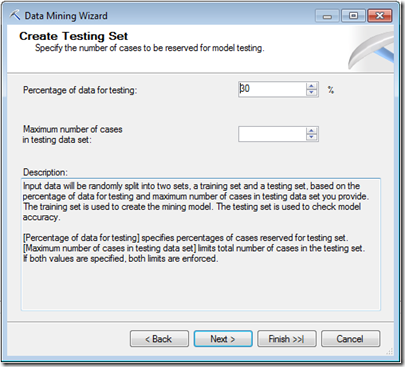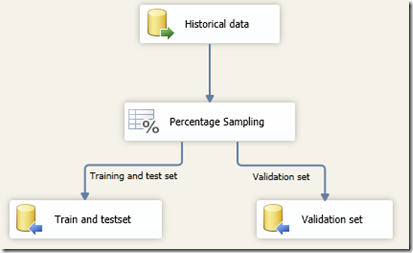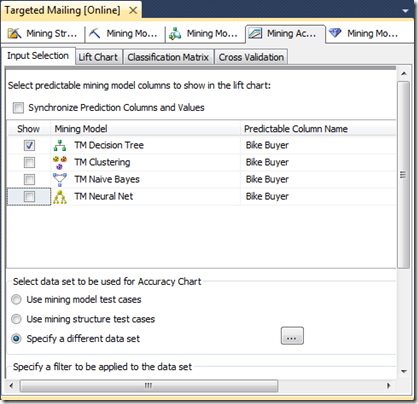What are validation sets?
Data Mining
Data mining analyses historical data to find patterns that might help us better understand how our business works, or might help predict how the business might evolve in the future: Instead of doing ‘traditional BI’, where we pick some attributes and ask for aggregated data (“show me the sum of sales amount by country per fiscal quarter”), in data mining we ask questions such as “what is typical for customers who buy bikes”, and we get answers (models, as we call them) that contain patterns such as “if the age of the customer is less than 29 and they live in the Netherlands they are more likely bike buyers”. This however results in a problem: how do we know if a model is ‘better’ than another model? Is the model “Young people are more frequent bike buyers” better than “People who do not own a car are bike buyers”?
Test set
The typical approach to test the quality of models is by testing how well they behave when we use them to predict the outcome (e.g. whether a customer buys a bike or not) on the historical data, for which we then already know the outcome. Models for which the predicted outcome more frequently corresponds with the actual outcome are better models. However, we need to be careful: if we would use as a test data set the same set of data we use to create the models, we run the risk of overfitting. Overfitting means the model is so tuned on the training set, that the patterns are not general enough to be useful on new data. E.g. the model “If the customer name is Ben Carlson, Margareta Wuyts, … or Jeremy Frank then it is a bike buyer” might make perfect predictions in your historical data, but it is clear that it will be of little help in making predictions on new customers: it is heavily overfitted. This is why we split the historical data in two sets: training data, on which the system search for patterns, and test data, which we use to test the quality of the model. This is even build-in in the SQL Server Analysis Services wizard to construct mining models: It by default proposes to keep 30% of the data separate for testing.

Validation set
But… also test data sets raise an issue: We often need to test a lot of different mining models with different parameter setting to find a near-optimal result. This is an iterative process, in which we create a few models, test them on the test set, see which data mining techniques and parameters work best, use that knowledge to setup a second iteration of models to be tested etc. But in this way, the data mining developer is introducing knowledge from the test set in the development process: Imagine that in our test set age is a strong indicator, than we will favor models which use this. The overall result is that the estimated quality of the predictions which are made on the test set are no longer a good estimate of the expected quality of the predictions on new data. They are already slightly biased towards our test set, and typically overestimate the predictive quality of our model.
This is where validation sets come in: Before we got started with any data mining in the first place, we should have set some of our historical data (e.g. 20% of the data) apart in a validation set. The remaining 80% is then split apart in training and test data. Once we’re finished with our data mining, we test our model one last time, on data it has never seen, not as training data, not as test data. Our validation set is (from the data mining point of view) truly new data, and might give the best impression of the expected predictive quality of our mining model.
How do we create validation sets?
In contrast to test data sets, the mining wizard does not allow us to set apart a validation set. So we need to do this in the data preparation phase (see CRISP-DM methodology for more info on the different phases in the data mining process). If you prefer to prepare your data with T-SQL statements, you can use this approach based on NEWID() to randomly select a certain set of data, but be careful: if you rerun the statement, a different subset will be selected.
Another approach is to use SSIS (Integration Services), which has a percentage sampling transformation which is ideal for this job: it assigns each row an n% likelihood of being selected, so because of that it doesn’t need to cache all rows in memory (in contrast to the row sampling transformation). An advantage over the NEWID() approach is that we can set the seed for the random data generator, such that results are reproducible if we want.

How do we use validation sets?
Using validation sets is easy. Just make sure that the table you created with the validation data is in the same data source as the data source you used for the SSAS project. Then in the Mining Accuracy Chart tab of the Mining model in SSAS, you select just the best performing model(s) and below you choose the radio button to use a different data set.

Click the ellipsis button (…) and select the table or view which contains the validation set. Join the proper columns from the validation set with the mining model, and you’re set! Now you can create lift or profit charts and build a classification matrix against the validation set.
Happy mining!
Nico